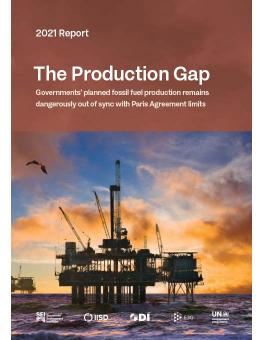
The Production Gap
2021 Report
The report, first launched in 2019, measures the gap between governments' planned production of coal, oil, and gas and the global production levels consistent with meeting the Paris Agreement temperature limits. Two years later, the 2021 report finds the production gap largely unchanged.
-
The world’s governments plan to produce ~110% more fossil fuels in 2030 than would be consistent with limiting warming to 1.5°C and 45% more than consistent with 2°C. The production gap has remained largely unchanged compared to prior assessments.
-
Governments’ production plans and projections would lead to about 240% more coal, 57% more oil, and 71% more gas in 2030 than would be consistent with limiting global warming to 1.5°C.
-
Global gas production is projected to increase the most between 2020 and 2040 based on governments’ plans. This continued, long-term global expansion in gas production is inconsistent with the Paris Agreement’s temperature limits.
The 2021 Production Gap Report, by leading research institutes and the UN Environment Programme (UNEP), finds that despite increased climate ambitions and net-zero commitments, governments still plan to produce more than double the amount of fossil fuels in 2030 than what would be consistent with limiting global warming to 1.5°C.
The report’s main findings include:
- The world’s governments plan to produce around 110% more fossil fuels in 2030 than would be consistent with limiting warming to 1.5°C, and 45% more than consistent with 2°C. The size of the production gap has remained largely unchanged compared to our prior assessments.
- Governments’ production plans and projections would lead to about 240% more coal, 57% more oil, and 71% more gas in 2030 than would be consistent with limiting global warming to 1.5°C.
- Global gas production is projected to increase the most between 2020 and 2040 based on governments’ plans. This continued, long-term global expansion in gas production is inconsistent with the Paris Agreement’s temperature limits.
- Countries have directed over USD 300 billion in new funds towards fossil fuel activities since the beginning of the COVID-19 pandemic—more than they have towards clean energy.
- In contrast, international public finance for the production of fossil fuels from G20 countries and major multilateral development banks (MDBs) has significantly decreased in recent years; one-third of MDBs and G20 development finance institutions (DFIs) by asset size have adopted policies that exclude fossil fuel production activities from future finance.
- Verifiable and comparable information on fossil fuel production and support—from both governments and companies—is essential to addressing the production gap.
You might also be interested in
Governments are subsidizing the destruction of nature even as they promise to protect it
When dignitaries from 196 countries converge in Montreal next week to rub shoulders and hash out a new global agreement to save nature, money will be on the agenda.
COP27 diary (November 16): '$100 billion in climate finance more of gesture from rich countries'
The 27th Conference of Parties (COP27) to the United Nations Framework Convention on Climate Change in Sharm El-Sheikh, Egypt, began November 7, 2022. Here’s a look at what happened on day 10 of COP27 climate talks. The draft text for a cover decision is yet to be produced by the COP27 Presidency as of 7.30 am November 17, leading many to wonder how long discussions will continue to arrive at a consensus on the document once released. Just two days of the summit remain.
Report Calls on Fossil Fuel Producers to Map “Transition Away” in NDCs
With governments due to submit the next generation of NDCs in 2025 a new report identifies five elements countries should include to reflect the outcome of the global stocktake.
At long last, Canada restricts oil and gas subsidies (except for all the loopholes)
Environment and Climate Minister Steven Guilbeault has unveiled detailed plans to phase out "inefficient" oil and gas subsidies, based on guidelines released yesterday morning that take effect immediately and are meant to fulfill a 14-year-old pledge by G20 countries.